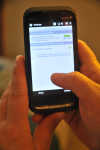Posting photos online can help criminals track you

Social networking, smartphones and online photo sharing have become increasingly more popular, but experts say there are some dangers involved with posting photos on the Internet.
Because of metadata, a criminal can find the location of a person who has posted photos on a social media platform or other website from a camera-enabled mobile phone at any time, Bourbon County Emergency Manager Keith Jeffers said.
Metadata are bits of information embedded in images taken with smartphones, webcams and some digital cameras and then shared on public websites. Information often includes the times, dates and geographical coordinates (latitude and longitude) where images are taken. Details such as where a person lives and works and their travel patterns and habits can unwittingly be revealed through metadata.
"It's been proven that some cases in the past have been because people picked up GPS locations on a picture," Jeffers said.
While the geospatial data can be helpful in a myriad of web applications that plot image locations, it also opens a door for criminals, including burglars, stalkers and predators. It's not a stretch to imagine young teens' images of their ventures to the mall or beach being culled by web predators and meticulously plotted on online maps, a news release said.
"It's not something we think is happening; we know it's happening," Kevin Gutfleish, head of the Innocent Images Intelligence Unit in the FBI's Cyber Division, said in the release.
The unit provides analysis and assessments of emerging threats for the operational arm of the Innocent Images National Initiative, which targets child pornography and sexual predators.
Jeffers said criminal activity is "happening more and more. As bad guys figure out how to use the technology more, they're able to exploit people and children."
People who want to use information to their advantage only need to enter the latitude and longitude coordinates into a program such as Google Earth to find someone's location, Jeffers said.
"They're handing criminals' information," he said. "Most times they can right click on a picture, open up the metadata, put it in Google Earth and pinpoint the location."
Jeffers said GPS technology and data can be very beneficial but also very dangerous if it falls into the wrong hands. First responders use GPS to find accident victims more easily, and emergency management departments use it for mapping purposes in the event of a large disaster. Appraisers use GPS to get correct property lines for appraising property. It is also used to find or track responders during an emergency.
"If someone is injured or in an accident and they have a smartphone turned to GPS, they can be found through the phone company or 911 locating," he said. "We can get real close with that. They can tell it (the device) not to be imprinting on their pictures."
Jeffers said there is normally a walk-through application on the phone that tells the user how to change settings so data will not be imprinted on their photos, or they can call the phone company for instructions. Most phones have a setting that only reveals date and time but not a physical location.
"If they take a picture and don't have a concern, then they don't need to worry about changing the settings," he said. "But they can tell it not to share data."
While each phone varies, on some of the more popular phone models users can go to the "Location Services" folder to disable the photo geotagging function.
Some popular social media sites automatically scrub metadata from images before they are published. On the other hand, some leverage the data to display location information beside the images, the release said.
"Even if they don't intentionally say where they are, the photos could reveal that," Gutfleish said in the release. "And that could present a potential danger."
Gutfleish said he has seen an increase in intelligence reports and complaints about the potential misuse of metadata embedded in photos. He said the proliferation of online tools that aggregate personal information from social networking and image hosting sites is enough to urge a level of caution, the release said.
He suggests mobile phone users at the very least check the "options" or "settings" on their phones (and any applicable mobile applications) to see if they are sharing location information. In many cases, the default setting is to share location information.
"It's just a best practice if you don't want to give out your location," he said in the release. "We simply want to make sure people know this is happening."
